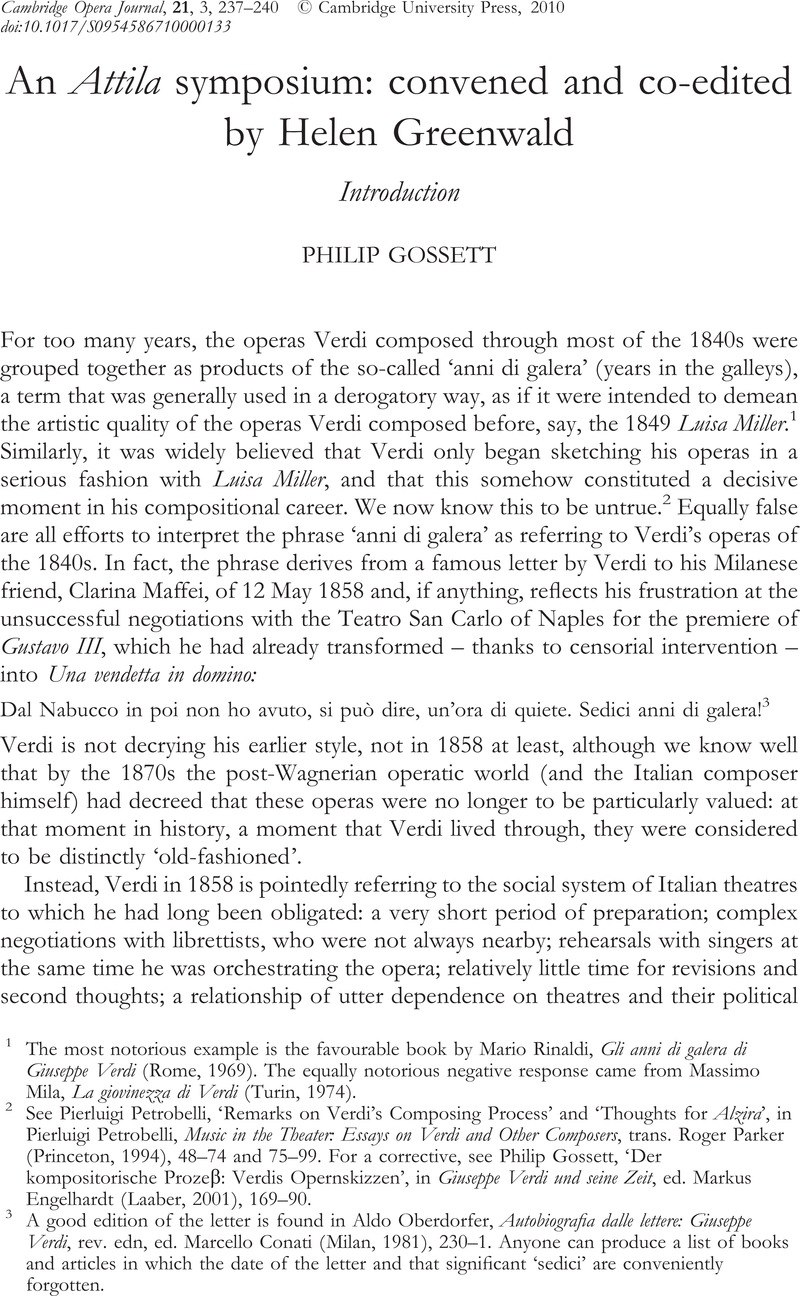Article contents
An Attila symposium: convened and co-edited by Helen Greenwald
Introduction
Published online by Cambridge University Press: 04 October 2010
Abstract

- Type
- Introduction
- Information
- Copyright
- Copyright © Cambridge University Press 2010
References
1 The most notorious example is the favourable book by Rinaldi, Mario, Gli anni di galera di Giuseppe Verdi (Rome, 1969)Google Scholar . The equally notorious negative response came from Mila, Massimo, La giovinezza di Verdi (Turin, 1974)Google Scholar .
2 See Petrobelli, Pierluigi, ‘Remarks on Verdi's Composing Process’ and ‘Thoughts for Alzira’, in Petrobelli, Pierluigi, Music in the Theater: Essays on Verdi and Other Composers, trans. Parker, Roger (Princeton, 1994), 48–74Google Scholar and 75–99. For a corrective, see Gossett, Philip, ‘Der kompositorische Prozeβ: Verdis Opernskizzen’, in Giuseppe Verdi und seine Zeit, ed. Engelhardt, Markus (Laaber, 2001), 169–190Google Scholar .
3 A good edition of the letter is found in Oberdorfer, Aldo, Autobiografia dalle lettere: Giuseppe Verdi, rev. edn, ed. Conati, Marcello (Milan, 1981), 230–231Google Scholar . Anyone can produce a list of books and articles in which the date of the letter and that significant ‘sedici’ are conveniently forgotten.
4 A bibliography of such writing would be extensive and seems quite unnecessary: readers of the Cambridge Opera Journal understand what I mean.
5 See Castelvecchi's, Stefano‘Walter Scott, Rossini e la couleur ossianique: il contesto culturale della Donna del lago’, Bolletino del centro rossiniano di studi, 33 (1993), 57–71Google Scholar . The critical edition of the opera was prepared by H. Colin Slim. See Rossini, Gioachino, La donna del lago, Edizione critica delle opere di Gioachino Rossini, Sezione prima: Opere Teatrali, vol. 29 (Pesaro, 1990)Google Scholar .
6 See Izzo, Francesco, ‘Verdi's Un giorno di regno: Two newly discovered movements and some questions of genre’, Acta Musicologia, 73 (2001), 165–188CrossRefGoogle Scholar . Izzo is currently working on the critical edition of Un giorno di regno, scheduled for publication in The Works of Giuseppe Verdi, Series I, vol. 2 (Chicago and Milan: The University of Chicago Press and Ricordi) in 2011.
7 Roberta Marvin's edition of Verdi's I masnadieri (2004) prompted her research into the role of Verdi's music in Victorian England, and her Verdi and the Victorians (Woodbridge: Boydell & Brewer, forthcoming, 2011), will offer the fullest treatment of her discoveries.
8 See Izzo, , ‘Verdi, the Virgin, and the Censor: The politics of the cult of Mary in I Lombardi alla prima crociata and Giovanna d'Arco’, Journal of the American Musicological Society, 60 (2007), 557–597CrossRefGoogle Scholar . The critical edition of Giovanna d'Arco (2007) was prepared by Alberto Rizzuti.
9 My own work editing Rossini and Verdi led to studies such as ‘History and Works That Have No History: Reviving Rossini's Neapolitan operas', in Disciplining Music: Musicology and Its Canons, ed. Katherine Bergeron and Philip V. Bohlman (Chicago, 1992), 95–115, and ‘“Edizioni distrutte” and the Significance of Operatic Choruses during the Risorgimento’, in Opera and Society in Italy and France from Monteverdi to Bourdieu, ed. Victoria Johnson, Jane F. Fulcher, and Thoms Ertman (Cambridge, 2007), 181–242. More general treatments of the problem of censorship motivated Andreas Giger's ‘Social Control and the Censorship of Giuseppe Verdi's Operas in Rome (1844–1859)’, this journal, 11 (1999), 233–65, which in turn led to his undertaking the critical edition of Verdi's 1844 opera for Rome, I due Foscari.
10 Verdi's interactions with Sofia Loewe are of particular interest, since it was Loewe who desperately wanted to conclude Ernani – of which she was the original Elvira – with a big aria for herself, whereas Verdi knew that the opera had to conclude with a trio. For further details see the Preface to the critical edition of Ernani, ed. Claudio Gallico (1985). Current scholarship on singers includes Poriss, Hilary, Changing the Score: Arias, Prima Donnas and the Authority of Performance (New York, 2009)CrossRefGoogle Scholar , and Rachel Cowgill and Hilary Poriss, eds., The Arts of the Prima Donna in the Long Nineteenth Century (Oxford University Press, in preparation). Important groundwork was laid by Mary Ann Smart; see, in particular, ‘The Lost Voice of Rosine Stolz’, this journal, 6 (1994), 31–50, and ‘Verdi Sings Erminia Frezzolini’, Verdi Newsletter, 24 (1997), 13–22.
11 This piece, long thought lost, is described in Gossett, Philip, ‘A New Romanza for Attila’, Studi verdiani, 9 (1993), 13–35Google Scholar .
12 A previous edition of this piece was prepared by Emanuele Senici and published by the Istituto Nazionale di Studi Verdiani in 2001.
13 Very important and still to be considered, for example, are the singers for whom Verdi was writing, particularly Ignazio Marini as Attila and Sofia Loewe as Odabella. There is also more to be said about Verdi's structural choices, his tonal design, his orchestration as well as the visual aspects of Attila, especially Verdi's use of the great Raphael fresco in the Vatican of Pope Leo I defending Rome against the barbarians. Helen Greenwald addresses the latter topic in her ongoing work, but did not have the space to discuss it in the current essay. See also Gossett, , Divas and Scholars: Performing Italian Opera (Chicago, 2006), 465CrossRefGoogle Scholar .
- 1
- Cited by


